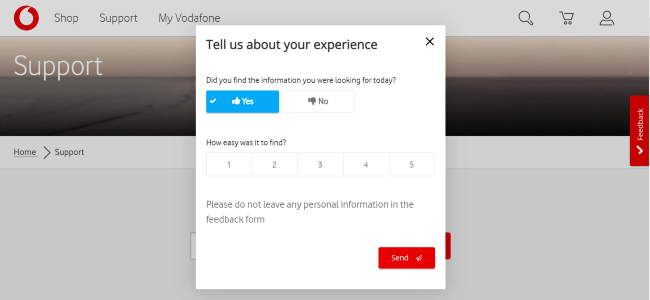The consumer has changed. Spending patterns have changed. Consumers are more critical than ever before, and that creates even more challenges for you as a CX Specialist. So how do you deal with this? How do you ensure that customers stay by your side and targets are met? Now is the time to excel with a customer experience that stays with your customers. In this post we will explain how to do just that.
In this post, you’ll learn about:
- The biggest challenges for a CX specialist
- Most common mistakes made in CX
- Ingredients for the best CX
- Feedback and the ideal CX

So before we get to the reasons behind why every CX specialist needs user feedback, let’s take a step back and look at what challenges and hurdles these roles face.
This biggest challenges for a CX specialist
As a CX Specialist, your to-do list is full of challenges. You want to improve the customer lifecycle and you can do that by raising the customer experience to the highest attainable level. Unfortunately, that is not always the case.
When you think of customer experience, you often automatically think of conversion optimisation. You don’t just want to offer a good CX, you also want visitors to convert. In this blog you can read why you need qualitative data for your CRO strategy and how you can use it.
The customer experience consists of all the moments of contact between your company and the customer. The most important thing is that you meet or even exceed your customer’s expectations in each of these moments.
By measuring the different touchpoints across various channels and combining the right data, you can obtain a more holistic view of your customers. Therefore, it is important to collect customer data at all important moments, such as contact with customer service, within email campaigns or on your mobile app. This gives you a better indication of the customer experience and where you stand with your customers.
At the same time, this also presents a challenge as you will have to be able to compare all data that comes in via the different channels. You simply cannot compare ‘apples with oranges’ or smileys with numbers. So try to find a manner in which you can assign a certain value to the different score so that you can use the data.
Another big challenge for CX Specialists is the collaboration with other teams and colleagues, such as product owners, the development team, marketing, customer support, etc. Your role demands that you are the point of contact when it comes to the customer experience, so it is your responsibility to ensure that new ideas and points for improvement reach the right people. If you can substantiate your findings, there is a greater chance that the other teams will pick up your ideas and implement them. Sure, you can impress colleagues with great reports and statistics, but you can really convince them of change with feedback from actual customers and users.

Most common mistakes made in CX
Many companies want to improve the customer experience because it’s ‘what they’re supposed to do’. They’ve read about it, but don’t really know how to approach it. On top of that, not everyone in an organisation is aware of CX initiatives which can be staggering to the success of your efforts. This ranges from small mistakes to major mistakes that can cost you your customers. So read this carefully to make sure you don’t make these mistakes.
1. Having tunnel vision. Even if you receive a lot of negative feedback, keep it in perspective and don’t get stressed. How many customers use your product and how many complain? We tend to give negative words more weight than positive words. In addition, not everyone who has a positive opinion will share it with you.
2. Lack of familiarity with your users. We also regularly see that there is little to know attention paid towards the type of user. Let’s say you have a banking app. Then it is important that you know who your users are. Are they daily or weekly users? Are they already familiar with this channel? You will therefore have to set up the CX properly for each target group, so that everyone can work well with your product.
3. Asking users obvious questions. What customers always find annoying is when they have to fill in information that you – as a company – already know. When someone buys something from you, they don’t want to fill in all kinds of superfluous information, so make sure your systems are well linked and you have the correct data. For example, by already filling in customer data, you prevent the purchase process from taking too long and someone dropping out as a result.
4. Poor accessibility. Finally, we would like to emphasise that a good CX is also reliant on the accessibility of your website or app. And that sounds very obvious, but is your product user-friendly for people with, for example, a visual impairment? Don’t forget that as many as one in four people have a disability, making it more difficult to achieve online goals.

Ingredients for the best CX
Now that you know which pitfalls CX Specialist run into, you can avoid them. But how do you create the ideal CX? How do you exceed your customers’ expectations? There are a number of “ingredients” that will help you improve the CX.
- Self-reliance. Make sure that customers can easily find answers to any questions and can arrange everything themselves online. In other words, give them a sense of independence and self-reliance. For example, Coolblue (a well-known Dutch ecommerce company) keeps track of which questions their customers ask about products. Then they make a video tutorial answering these questions which saves many customers from asking a lot of the same questions afterwards. The result? An increase in the number of satisfied customers.
- Customer feedback. By collecting customer feedback at all key touch points across the customer journey, you not only get to know your customers better, but also what’s stopping them from buying. You also get a good idea of how they see your brand and whether that corresponds with the message you’re sending.
- Empathy. Show that you know and understand your customers. Surprise your customers by responding to their needs and don’t forget to give the interactions a human touch. Nobody wants a chatbot that doesn’t understand the question. Fortunately, thanks to Artificial Intelligence, a lot is possible in this area.
- Personalisation. Although everyone knows how important personalisation is, not everyone is able to actually apply it. Thanks to handy tools, you can now easily identify personas and approach your customers in a targeted and more personal manner.
- Consistency. Whether it’s interaction via your website, app, email or offline, your customer deserves a consistent customer experience. By properly aligning all channels, you prevent confusion or irritation among your customers.

Feedback and the ideal CX
Let’s take a closer look at the role of feedback in the customer experience.
There is only one way to find out who your users are and the reason for their visit. That is simply asking your customers.
To illustrate, let us show you how we do this at Mopinion.
As an all-in-one digital user feedback software, Mopinion knows better than anyone how to ask customers and users for feedback without disrupting the digital customer experience. In addition to the personas we monitor, we also measure, for example, how often someone uses our product. This can tell you a lot about the CX.
Additionally, we look at the user’s knowledge and experience with using our product. How handy is someone with our product? Do they already have experience or are they a ‘newbie’? This determines how our CX scores on customer satisfaction and how much effort our users are putting into achieving their goals (by measuring Customer Effort Score (CES)).
In our mobile app, via the website or email campaigns we collect customer feedback during the different touchpoints and we get answers to important questions such as: Can you find what you are looking for? What do you think of this email? Why are you visiting our website? Can we somehow improve the app?
By asking these (open) questions carefully, you can discover more about why your visitors are giving you a certain score and what you can improve upon.
Let’s look at an example. Nowadays you often see smileys at the bottom of an email message. These enable email recipients to provide their feedback regarding the contents of the email. However the smiley score alone doesn’t tell you much. It’s more telling to know why your email receives that score.
As you can see in the feedback form from DHL (a global logistics company), there are smileys and an open comments field which enables recipients to explain their score. This feedback gives DHL a much better indication of how relevant and desirable their emails are.

Example of service email feedback from DHL
You can also use customer feedback to boost the quality of your content. In the example below, Vodafone Ireland has set out to tailor its content on the support page to its users’ needs.

Example of a content survey on Vodafone Ireland website
As you can see, there are plenty of opportunities to collect customer feedback. But the best and most effective way of learning more is experiencing it yourself. Be curious, try something new and take a look at how other companies make the CX special.
A customer experience to be remembered
By consistently collecting and analysing customer feedback, you will know what your customers and visitors need. Use this knowledge and surprise your customers. Before you know it, your customers will become your ambassadors.
Ready to see Mopinion in action?
Want to learn more about Mopinion’s all-in-1 user feedback platform? Don’t be shy and take our software for a spin! Do you prefer it a bit more personal? Just book a demo. One of our feedback pro’s will guide you through the software and answer any questions you may have.







